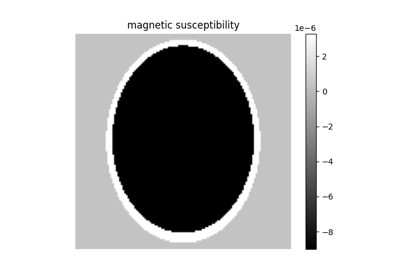b0field#
- mrtwin.b0field(chi, b0range=None, mask=None, B0=1.5)[source]#
Simulate inhomogeneous B0 fields.
Output field units is
[Hz]. The field is created by convolving the dipole kernel with an input magnetic susceptibility map.- Parameters:
chi (np.ndarray) – Object magnetic susceptibility map in
[ppb]of shape(ny, nx)(2D) or(nz, ny, nx)(3D).b0range (Sequence[float] | None, optional) – Range of B0 field in
[Hz]. The default isNone(do not force a range).mask (np.ndarray, optional) – Region of support of the object of shape
(ny, nx)(2D) or(nz, ny, nx)(3D). The default isNone.B0 (float, optional) – Static field strength in [T]. Used to compute B0 scaling (assuming 1H imaging) if b0range is not provided. The default is 1.5.
- Returns:
B0map – Spatially varying B0 maps of shape
(ny, nx)(2D) or(nz, ny, nx)(3D) in[Hz], arising from the object susceptibility.- Return type:
np.ndarray
Example
>>> from mrtwin import shepplogan_phantom, b0field
We can generate a 2D B0 field map of shape
(ny=128, nx=128)starting from a magnetic susceptibility distribution:>>> chi = shepplogan_phantom(2, 128, segtype=False).Chi >>> b0map = b0field(chi)
B0 values range can be specified using
b0rangeargument:>>> b0map = b0field(chi, b0range=(-500, 500))
